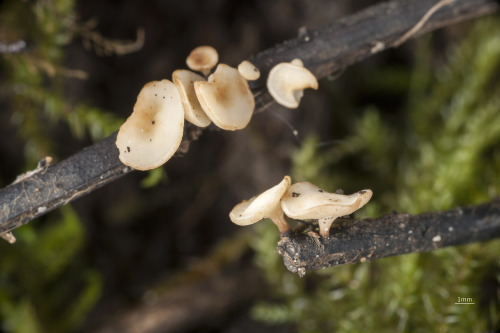Top Image Via The Roald Dahl Museum And Story Centre




Top image via The Roald Dahl Museum and Story Centre
Happy Roald Dahl Day, everyone!
Here’s a selection of some of our favorite stories about the man behind Matilda, Charlie and the Chocolate Factory, The BFG and all the other books that traumatized us so delightfully as kids (Vermicious Knids, eeeeeggghhh).
Roald Dahl Wanted His Magical ‘Matilda’ To Keep Books Alive
Roald Dahl, A Bottle Of Dreams And A 'Letter Of Note’
'Where Am I Now?’ Mara Wilson Explains What Happened When Matilda Grew Up
Roald Dahl: The Story Of The 'Storyteller’
And lest we forget – Dahl’s memoirs and fiction for adults are great too. Just don’t give Someone Like You to a kid.
Wicked And Delicious: Devouring Roald Dahl
– Petra
More Posts from Philosophical-amoeba and Others
Molecule of the Day: Chloroform


Chloroform (CHCl3) is a colourless, dense liquid that is immiscible with water at room temperature and pressure. Popularised by movies and dramas, it is often cited as an incapacitating agent in popular culture.
Chloroform was used as a general anaesthetic due to its ability to depress the central nervous system, a property that was discovered in 1842. This produced a medically-induced coma, allowing surgeons to operate on patients without them feeling any pain.

However, chloroform was found to be associated with many side effects, such as vomiting, nausea, jaundice, depression of the respiratory system, liver necrosis and tumour formation, and its use was gradually superseded in the early 20th century by other anaesthetics and sedatives such as diethyl ether and hexobarbital respectively.

While chloroform has been implicated in several criminal cases, its use as an incapacitating agent is largely restricted to fiction; the usage of a chloroform-soaked fabric to knock a person out would take at least 5 minutes.
Chloroform is metabolised in the liver to form phosgene, which can react with DNA and proteins. Additionally, phosgene is hydrolysed to produced hydrochloric acid. These are believed to cause chloroform’s nephrotoxicity.
Chloroform is often used as a reagent to produce dichlorocarbene in situ via its reaction with a base like sodium tert-butoxide. This is a useful precursor to many derivatives. For example, the dichlorocarbene can be reacted with alkenes to form cyclopropanes, which can be difficult to synthesise otherwise.

Chloroform is industrially synthesised by the free radical chlorination of methane:
CH4 + 3 Cl2 –> CHCl3 + 3 HCl
It can also be synthesised by the reaction of acetone with sodium hypochlorite in bleach by successive aldol-like reactions:







The psychiatrist who wrote the criteria for narcissism just made an extremely important point about what’s wrong with diagnosing Trump with mental disorders
Dr. Allen Frances says in speculating about Trump’s mental health, we are doing a disservice to those who do suffer from mental illness. In a series of tweets, he explained why he doesn’t think Trump is a narcissist — and how harmful it can be for us to keep assuming that he is.






Dress for the job you want.
Yoshiie Ason yoroi chakuyōzu 義家朝臣鎧着用次第 by Sadatake Ise is a pictorial work on how to put on Japanese Samurai armor. The subject is famed Samurai warrior Minamoto No Yoshiie.
Find more amazing rare books we’ve recently digitized from our Freer | Sackler branch library in our book collection, Japanese Illustrated Books from the Edo and Meiji Period.
A newspaper you can blow your nose on

Here are some pages from Berthold’s Political Handkerchief, a political newspaper printed on cotton to avoid the government’s tax on paper.
Henry Berthold was later arrested, charged with shoplifting a boa and dismissed to Australia.












Pride and Prejudice by Jane Austen Illustrated by Charles E Brock with an introduction by Austin Dobson London Macmillan and Co Limited 1895 / 1901 452 pages + ads, all page edges gilt, measures 187mm x 130mm
An attractive copy of a classic illustrated edition in the publishers salmon coloured cloth with swirling art nouveau design covers



Breakthrough on ash dieback
UK scientists have identified the country’s first ash tree that shows tolerance to ash dieback.
Ash dieback is spreading throughout the UK and in one woodland in Norfolk, a great number of trees are infected.
The team compared the genetics of trees with different levels of tolerance to ash dieback disease. From there, they developed three genetic markers which enabled them to predict whether or not a tree is likely to be tolerant to the disease. One tree named Betty, they discovered, was predicted to show strong tolerance.
The findings raise the possibility of using selective breeding to develop strains of trees that are tolerant to the disease to help safeguard our forests.
Read more
Images: Close-up infected ash petioles (leaf stems) - Copyright: John Innes Centre
The Normans - A Timeline
911: According to later writer Dudo of Saint-Quentin, in this year the king of the Franks, Charles the Simple, grants land around the city of Rouen to Rollo, or Rolf, leader of the Vikings who have settled the region: the duchy of Normandy is founded. In return Rollo undertakes to protect the area and to receive baptism, taking the Christian name Robert.
1002: Emma, sister of Duke Richard II of Normandy, marries Æthelred (‘the Unready’), king of England. Their son, the future Edward the Confessor, flees to Normandy 14 years later when England is conquered by King Cnut, and remains there for the next quarter of a century. This dynastic link is later used as one of the justifications for the Norman conquest.
1016: A group of Norman pilgrims en route to Jerusalem are ‘invited’ to help liberate southern Italy from Byzantine (Greek) control. Norman knights have already been operating as mercenaries here since the turn of the first millennium, selling their military services to rival Lombard, Greek and Muslim rulers.
1035: Having ruled Normandy for eight years, Duke Robert I falls ill on his return from
a pilgrimage to Jerusalem and dies at Nicaea. By prior agreement, Robert is succeeded by his illegitimate son William, the future Conqueror of England, then aged just seven or eight. A decade of violence follows as Norman nobles fight each other for control of the young duke and his duchy.
1051: Duke William visits England. His rule in Normandy now established, and newly married to Matilda of Flanders, William crosses the Channel to speak with his second cousin, King Edward the Confessor of England. The subject of their conference is unknown, but later chroniclers assert that at this time Edward promises William the English succession.
1059: Pope Nicholas II invests the Norman Robert Guiscard with the dukedoms of Apulia, Calabria and Sicily. The popes had opposed the ambitions of the Normans in Italy, but defeat in battle at Civitate in southern Italy in 1053 had caused them to reconsider. In 1060 Robert and his brother Roger embark on the conquest of Sicily, and Roger subsequently rules the island as its great count.
1066: Edward the Confessor dies on 5 January, and the throne is immediately taken by his brother-in-law Harold Godwinson, the most powerful earl in England, with strong popular backing. Harold defeats his Norwegian namesake at Stamford Bridge in September. But on 14 October William’s Norman forces defeat Harold’s army at Hastings. William is crowned as England’s king on Christmas Day.
1069: The initial years of William’s reign in England are marked by almost constant English rebellion, matched by violent Norman repression. In autumn 1069 a fresh English revolt is triggered by a Danish invasion. William responds by laying waste to the country north of the Humber, destroying crops and cattle in a campaign that becomes known as the Harrying of the North, leading to widespread famine and death.
1086: Worried by the threat of Danish invasion, at Christmas 1085 William decides to survey his kingdom – partly to assess its wealth, and partly to settle arguments about landownership created by 20 years of conquest. The results, later redacted and compiled as Domesday Book, are probably brought to him in August 1086 at Old Sarum (near Salisbury), where all landowners swear an oath to him.
1087: William retaliates against a French invasion of Normandy. While attacking Mantes he is taken ill or injured – possibly damaging his intestines on the pommel of his saddle – and retires to Rouen, where he dies on 9 September. Taken to Caen for burial, his body proves too fat for its stone sarcophagus, and bursts when monks try to force it in. His eldest surviving son, Robert Curthose, becomes duke of Normandy, while England passes to his second son, William Rufus.
1096: Following a call to arms by Pope Urban II in 1095, many Normans set out towards the Holy Land on the First Crusade, determined to recover Jerusalem. Among them are Robert Curthose, who mortgages Normandy to his younger brother, William Rufus, and William the Conqueror’s notorious half-brother, Bishop Odo of Bayeux. Odo dies en route and is buried in Palermo, but Robert goes on to win victories in Palestine and is present when Jerusalem falls.
1100: Having succeeded his father in 1087 and defeated Robert Curthose’s attempts to unseat him, the rule of William II (‘Rufus’, depicted below) seems secure. But on 2 August 1100, while hunting in the New Forest with some of his barons, William is struck by a stray arrow and killed. His body is carted to Winchester for burial, and the English throne passes to his younger brother, Henry, who is crowned in Westminster Abbey just three days later.
1101: Roger I of Sicily dies. By the end of his long rule, Count Roger has gained control over the whole of Sicily – the central Muslim town of Enna submitted in 1087, and the last emirs in the southeast surrendered in 1091. He is briefly succeeded by his eldest son, Simon, but the new count dies in 1105 and is succeeded by his younger brother, Roger II.
1120: On 25 November Henry I sets out across the Channel from Normandy to England. One of the vessels in his fleet, the White Ship, strikes a rock soon after its departure, with the loss of all but one of its passengers. One of the drowned is the king’s only legitimate son, William Ætheling. Henry responds by fixing the succession on his daughter, Matilda, and marrying her to Geoffrey Plantagenet, count of Anjou.
1130: Roger II is crowned king of Sicily, having pushed for royal status in order to assert his authority over the barons of southern Italy. A disputed papal succession in 1130 has provided an opportunity and, in return for support against a papal rival, Pope Anacletus II confers the kingship on Roger in September. He is crowned in Palermo Cathedral on Christmas Day.
1135: Henry I dies in Normandy on 1 December, reportedly after ignoring doctor’s orders and eating his favourite dish - lampreys. His body is shipped back to England for burial at the abbey he founded in Reading. Many of his barons reject the rule of his daughter, Matilda, instead backing his nephew, Stephen, who is crowned as England’s new king on 22 December.
1154: King Stephen, the last Norman king of England, dies. His death ends the vicious civil war between him and his cousin Matilda that lasted for most of his reign. As a result of the Treaty of Wallingford, which Stephen was pressured to sign in 1153, he is succeeded by Matilda’s son Henry of Anjou, who takes the throne as Henry II.
1174: King William II of Sicily begins the construction of the great church at Monreale (‘Mount Royal’), nine miles from his capital at Palermo. The building is a fusion of Byzantine, Latin and Muslim architectural styles, and is decorated throughout with gold mosaics, including the earliest depiction of Thomas Becket, martyred in 1170.
1194: Norman rule on Sicily ends. Tancred of Lecce, son of Roger III, Duke of Apulia, seizes the throne on William’s death in 1189; on his death in 1194 he is succeeded by his young son, William III. Eight months later, Holy Roman Emperor Henry VI, husband of Roger II’s daughter Constance, invades Sicily and is crowned in Palermo on Christmas Day. The following day, Constance gives birth to their son, the future Frederick II.
1204: King John loses Normandy to the French. The youngest son of Henry II, John had succeeded to England, Normandy, Anjou and Aquitaine after the death of his elder brother, Richard the Lionheart, in 1199. But in just five years he lost almost all of his continental lands to his rival King Philip Augustus of France – the end of England’s link with Normandy.





The Screwtape Letters C S Lewis London Geoffrey Bles - The Centenary Press 1942 - First Published February 1942, Reprinted March 1942, Reprinted March 1942
dedicated to J R R Tolkien

The hairstyle of this small girl, cut short and topped with a ribbon bow, seems to date this advertisement from the early 1950s. The printer is believed to be Whitcombe & Tombs, because the poster came to the Library with other material printed by that company.
[Whitcombe & Tombs Ltd?] :Goodness! that’s tempting. Weet-bix [ca 1954?]
Eph-C-FOOD-Whitcombe-2-03
-
 jashanjohal liked this · 6 years ago
jashanjohal liked this · 6 years ago -
 dante-doofenschmirtz liked this · 6 years ago
dante-doofenschmirtz liked this · 6 years ago -
 coolbooksandqoutes-blog reblogged this · 6 years ago
coolbooksandqoutes-blog reblogged this · 6 years ago -
 isabelsbookpromotions liked this · 7 years ago
isabelsbookpromotions liked this · 7 years ago -
 kickmoneydjcool reblogged this · 8 years ago
kickmoneydjcool reblogged this · 8 years ago -
 thelazybookcollector reblogged this · 8 years ago
thelazybookcollector reblogged this · 8 years ago -
 how-it-fx-you reblogged this · 8 years ago
how-it-fx-you reblogged this · 8 years ago -
 bethleslie31 liked this · 8 years ago
bethleslie31 liked this · 8 years ago -
 maxum-the-mage liked this · 8 years ago
maxum-the-mage liked this · 8 years ago -
 unbearable-lightness-of-ink reblogged this · 8 years ago
unbearable-lightness-of-ink reblogged this · 8 years ago -
 kattrill-blog reblogged this · 8 years ago
kattrill-blog reblogged this · 8 years ago -
 extraordinaryadg liked this · 8 years ago
extraordinaryadg liked this · 8 years ago -
 leastrestrictiveenvironment-blog liked this · 8 years ago
leastrestrictiveenvironment-blog liked this · 8 years ago -
 a-sad-fat-dragon-with-no-friends reblogged this · 8 years ago
a-sad-fat-dragon-with-no-friends reblogged this · 8 years ago -
 atlantianempress liked this · 8 years ago
atlantianempress liked this · 8 years ago -
 alot-of-kiwi liked this · 8 years ago
alot-of-kiwi liked this · 8 years ago -
 thelifeofraegan liked this · 8 years ago
thelifeofraegan liked this · 8 years ago -
 cran-crann liked this · 8 years ago
cran-crann liked this · 8 years ago -
 likeitsherjob liked this · 8 years ago
likeitsherjob liked this · 8 years ago -
 totallyoutthere liked this · 8 years ago
totallyoutthere liked this · 8 years ago -
 naughty-noir liked this · 8 years ago
naughty-noir liked this · 8 years ago -
 anto29860 liked this · 8 years ago
anto29860 liked this · 8 years ago -
 marxparx-blog reblogged this · 8 years ago
marxparx-blog reblogged this · 8 years ago -
 linaaaaa liked this · 8 years ago
linaaaaa liked this · 8 years ago -
 scottiewaves liked this · 8 years ago
scottiewaves liked this · 8 years ago -
 pardonalways reblogged this · 8 years ago
pardonalways reblogged this · 8 years ago -
 shivaunsletter liked this · 8 years ago
shivaunsletter liked this · 8 years ago -
 thefourthpurpleone liked this · 8 years ago
thefourthpurpleone liked this · 8 years ago -
 chaoticunplannedlife liked this · 8 years ago
chaoticunplannedlife liked this · 8 years ago -
 lundrues reblogged this · 8 years ago
lundrues reblogged this · 8 years ago -
 asheetoftissuepaper reblogged this · 8 years ago
asheetoftissuepaper reblogged this · 8 years ago -
 scubagina liked this · 8 years ago
scubagina liked this · 8 years ago -
 scott1845 liked this · 8 years ago
scott1845 liked this · 8 years ago -
 bricktreehouse liked this · 8 years ago
bricktreehouse liked this · 8 years ago -
 momwithasmartphone liked this · 8 years ago
momwithasmartphone liked this · 8 years ago -
 mermaidbones liked this · 8 years ago
mermaidbones liked this · 8 years ago -
 confusementation liked this · 8 years ago
confusementation liked this · 8 years ago -
 nicolekidmanwigfactory reblogged this · 8 years ago
nicolekidmanwigfactory reblogged this · 8 years ago -
 gtpubliclibrary reblogged this · 8 years ago
gtpubliclibrary reblogged this · 8 years ago -
 deckerlibrary liked this · 8 years ago
deckerlibrary liked this · 8 years ago
A reblog of nerdy and quirky stuff that pique my interest.
291 posts
